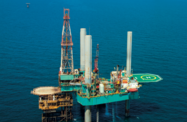Looking to reduce its imports and at the same time meet growing energy demands, Abu Dhabi is seeking to develop its sour gas reserves, both on and off-shore.
Gas is used extensively for electricity generation, water desalination and as an industrial feedstock in the emirate, and demand on all fronts is rising rapidly. Indeed, according to Abu Dhabi Water and Electricity Authority (ADWEA), power consumption is set to rise by 11.3% annually.
But with much of Abu Dhabi’s existing gas production already committed for export, the current gap in domestic demand is being bridged via imports from Qatar. As this divide is expected to widen further in the coming years, developing local sour gas production is seen as the answer.
In the works
Sour, or tight gas as it is sometimes known, has high concentrations of other elements, often hydrogen sulphide (H2S) or carbon dioxide (CO2), which are toxic and corrosive. Until relatively recently, the cost of processing sour gas to remove these other elements to make it usable has been too high to make it commercially viable. However, increasing demand and improved technology have changed this.
Currently, Abu Dhabi has a number of sour gas projects under development. The emirate’s latest solution to the gas equation is also one of its most technologically pioneering: to produce and process gas from the onshore Shah field, most of which is deemed sour.
When up and running, which according to the current schedule should be operational in early 2015, the $10bn natural gas project, a joint development between ADNOC and US-based Occidental Petroleum, is expected to produce 14.2m cu metres of gas per day.
Another project is the Bab field, located around 150km to the south west of the city of Abu Dhabi. A joint project between Abu Dhabi National Oil Company (ADNOC) and Shell, with an estimated development cost of $10bn, the field is expected to go into production in 2020, adding more than 14m cu metres of gas per day to available stocks.
A third sour gas field is located off Abu Dhabi’s coast in relatively shallow water, but has yet to be developed. While the Hail field has a number of advantages over the major onshore deposits – for example, it has a far lower CO2 or H2S content than Shah or Bab, meaning the processing cost should be lower – its location could be a drawback.
The Hail gas reservoir lies under a significant oil deposit, and the two are separated by a layer of rock. Though the concession for the development of the oil reservoir has been granted to ADNOC and an engineering and design contract was awarded to French engineering company Technip in April, a more detailed study of the requirements of tapping the gas deposit will be required.
An integrated approach
The development of Abu Dhabi’s sour gas is not without its challenges. Deep drilling in some fields presents its own set of difficulties, as does having to deploy advanced technology to meet the specific requirements of these fields, along with the infrastructure necessary to handle the toxic and corrosive by-products that the extraction process generates.
According to Andrew Vaughn, Shell’s country chairman, the technical requirements for the project will stretch the limits of the industry.
“Bab contains one of the largest non-associated gas fields in the UAE and its development will be extremely challenging,” he told OBG. “The most interesting aspect of the project will be the combination of technologies that will have to be used to extract and process the natural gas. It will require an integrated approach bringing together many different technical and operational solutions.”
These technical issues also have the potential to drive up the costs of developing sour gas. According to some estimates, the cost of sulphur extraction from the Shah field could well be in excess of the price levied for imports from Qatar. With the even higher levels of H2S and CO2 in the Bab reservoir, the per unit cost of delivering gas to the market from this field could soar further. Added to this will be the greater expense of maintaining pipelines and equipment, necessary due to the corrosive nature of the sour gas being extracted.
While it is hoped higher extraction and processing costs will be offset by sales of the refined sulphur separated from the gas, this will depend on international sulphur prices, which fluctuate. This uncertainty in the market will make it difficult to factor in hard returns from the derivatives side of the operations.
Follow Oxford Business Group on Facebook, Google+ and Twitter for all the latest Economic News Updates. Or register to receive updates via email.

